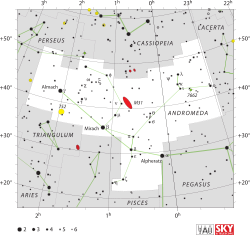Andromeda (constellation)
| Constellation | |

|
|
| Abbreviation | And |
|---|---|
| Genitive | Andromedae |
| Pronunciation |
|
| Symbolism |
Andromeda, the Chained Woman |
| Right ascension | 23h 25m 48.6945s–02h 39m 32.5149s |
| Declination | 53.1870041°–21.6766376° |
| Family | Perseus |
| Area | 722 sq. deg. (19th) |
| Main stars | 16 |
|
Bayer/Flamsteed stars |
65 |
| Stars with planets | 12 |
| Stars brighter than 3.00m | 3 |
| Stars within 10.00 pc (32.62 ly) | 3 |
| Brightest star | α And (Alpheratz) (2.07m) |
| Nearest star |
Ross 248 (10.30 ly, 3.16 pc) |
| Messier objects | 3 |
| Meteor showers | Andromedids (Bielids) |
| Bordering constellations |
|
|
Visible at latitudes between +90° and −40°. Best visible at 21:00 (9 p.m.) during the month of November. |
|
Andromeda is one of the 48 constellations listed by the 2nd-century Greco-Roman astronomer Ptolemy and remains one of the 88 modern constellations. Located north of the celestial equator, it is named for Andromeda, daughter of Cassiopeia, in the Greek myth, who was chained to a rock to be eaten by the sea monster Cetus. Andromeda is most prominent during autumn evenings in the Northern Hemisphere, along with several other constellations named for characters in the Perseus myth. Because of its northern declination, Andromeda is visible only north of 40° south latitude; for observers farther south it lies below the horizon. It is one of the largest constellations, with an area of 722 square degrees. This is over 1,400 times the size of the full moon, 55% of the size of the largest constellation, Hydra, and over 10 times the size of the smallest constellation, Crux.
Its brightest star, Alpha Andromedae, is a binary star that has also been counted as a part of Pegasus, while Gamma Andromedae is a colorful binary and a popular target for amateur astronomers. Only marginally dimmer than Alpha, Beta Andromedae is a red giant, its color visible to the naked eye. The constellation's most obvious deep-sky object is the naked-eye Andromeda Galaxy (M31, also called the Great Galaxy of Andromeda), the closest spiral galaxy to the Milky Way and one of the brightest Messier objects. Several fainter galaxies, including M31's companions M110 and M32, as well as the more distant NGC 891, lie within Andromeda. The Blue Snowball Nebula, a planetary nebula, is visible in a telescope as a blue circular object.
...
Wikipedia
